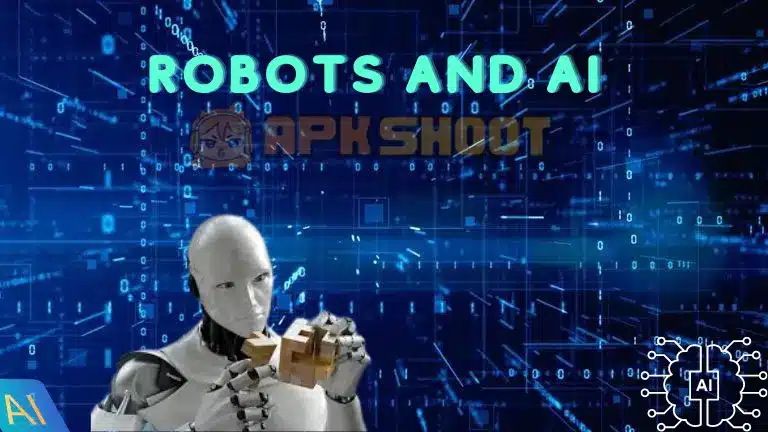Robots and artificial intelligence (AI) are becoming more famous in a variety of businesses. With the help of technological improvements, the combination of robots and AI results in important developments.
The combination of robots and artificial intelligence (AI) has created new opportunities in several sectors. Robotics uses artificial intelligence in its database. This article highlights AI’s huge effects on robotics and how it is affecting our future life. The combination of AI and robotics are changing many industries, from autonomous cars to personal assistants, creating the way for a more efficient and sophisticated society.
Definition of Robotics and Artificial Intelligence
It is necessary to understand the basic concepts of robotics and artificial intelligence before we go toward the applications and advantages of robotics. Robotics is an engineering and scientific multiple disciplines fields. They focus on the design, development, and use of robots. Artificial intelligence, on the other hand, is the field of computer science that enables machines to do tasks that normally need human intelligence.

Understanding Artificial Intelligence
AI enables robots to understand and make decisions similar to how humans do. Robots can analyze large amounts of data, adapt to changing settings, and enhance their performance over time by employing AI algorithms.
Artificial intelligence is a subfield of computer science that focuses on developing intelligent machines that can replicate human intellect. Artificial intelligence (AI) enables robots to see, reason, learn, and make decisions, boosting their usefulness and adaptability.
Robotics: An Overview:
Robotics is an interdisciplinary field that brings together engineering, computer science, and other disciplines to design, create, and operate robots. Robots are physical entities capable of doing activities independently or semi-autonomously, with different levels of human interaction.
Application of Robotics
Robotics has a wide range of applications. Robots have revolutionized manufacturing processes by automating repetitive activities and increasing efficiency. They can handle complicated assembly operations with precision and speed, resulting in increased efficiency and cost savings. Furthermore, robots are widely utilized in healthcare, aiding surgeons, giving physical therapy, and delivering medication. They are also used in agriculture, logistics, exploration, and even in our daily life as domestic helpers.
Role of Artificial Intelligence in Robotics
Artificial intelligence plays an essential role in enabling robots to do tasks intelligently. Robots may adapt to dynamic settings, learn from experience, and make autonomous judgments by implementing AI algorithms and machine learning techniques. The use of AI in robotics receives and understands sensory input, recognizes things, navigates complicated situations, and communicates naturally and intuitively with humans. This combination of artificial intelligence and robotics improves their capacity to perform complicated tasks and make real-time modifications.
Benefits of Robotic Automation
Across sectors, robotic automation has several advantages. For starters, it boosts efficiency and production by decreasing human error and allowing for continuous operation. Robots can operate indefinitely while maintaining great precision and accuracy, resulting in improved quality control. Furthermore, robotics reduces the dangers connected with dangerous occupations, boosting worker safety. It also contributes to cost savings since robots can do activities more quickly and effectively, lowering labor expenses and waste.
Challenges and Limitations
Despite progress, robots and artificial intelligence have hurdles and limitations. The potential replacement of human labor in particular industries is a big problem. Concerns about job loss and the need to upskill the workforce develop when robots take over monotonous and physical activities. Furthermore, the creation of complex AI algorithms necessitates significant computational resources and experience, which might be prohibitively expensive for smaller organizations or those lacking technological competence. Furthermore, there are questions about the ethical implications of robotics and AI, such as violation of privacy and biased decision-making. It is critical to ensure the proper development and deployment of robots and AI to successfully handle these issues and constraints.
Challenges and Future Prospects:
1. Ethical Considerations
Integrating AI and robotics creates ethical concerns about privacy, security, and human-machine interaction. As these technologies advance in sophistication, addressing these problems becomes increasingly important for their responsible and ethical deployment.

2. Advancements in Machine Learning:
Machine learning techniques, deep learning, and neural networks will continue to evolve, enhancing the capabilities of AI-powered robots. Robots will be able to learn and adapt more efficiently, leading to more complex and sophisticated behaviors.
3. Collaborative Robots (Cobots)
Cobots, or collaborative robots, are meant to work alongside people, complementing their skills and increasing efficiency. Cobots use artificial intelligence to comprehend human intents, adapt to changing circumstances, and ensure safe and efficient cooperation.
4. Ethical Considerations
The integration of robots and AI poses ethical concerns that must be handled properly. One critical consideration is the possible impact on employment. While robots and automation might increase production, job loss remains a worry. It is critical to strike a balance between the advantages of automation and the well-being of the workforce, which might be accomplished through retraining programs and the creation of new employment possibilities.
Another ethical issue to address is the employment of AI in autonomous systems like self-driving vehicles or drones. To ensure the protection of human lives and property, safety, accountability, and decision-making procedures must be properly assessed. To avoid Discriminatory outcomes, AI systems must be transparent, explainable, and free of prejudice.
Future of Robotics and AI
The future of robots and AI has great potential. We should expect increasingly complex and intelligent robots that can smoothly integrate into all facets of our life as technology advances. The integration of robots, artificial intelligence (AI), and other developing technologies such as the Internet of Things (IoT) and cloud computing may open up new avenues for automation, personal support, and healthcare.
In the sphere of healthcare, AI-enabled robots can help with diagnosis, surgeries, and patient care. They can enhance medical practitioners’ abilities, resulting in more accurate diagnoses, personalized treatment regimens, and better patient outcomes. Similarly, in the industrial business, robots will become more versatile and adaptive, allowing them to collaborate with humans in complex assembly procedures.
Conclusion
The combination of robots and artificial intelligence is transforming a wide range of businesses and areas. The collaboration of these two domains enables robots to perform complicated jobs intelligently, resulting in greater efficiency, safety, and production. However, addressing issues such as employment displacement, ethical considerations, and responsible AI algorithm development is critical.
As we move forward, it will be critical to embrace the possibilities of robots and AI while also evaluating the impact on society. We can guarantee that robotics and AI contribute to a more sustainable and inclusive future by encouraging collaboration among technology developers, politicians, and society as a whole.
Related Articles
- The Best Programming Language for Artificial Intelligence
- Free Fire Redeem Active Codes
- The Future of Artificial Intelligence
- How AI is Changing Our World
FAQ
While robots and automation can replace certain tasks and job roles, the complete replacement of human workers is unlikely. Instead, robots and humans can collaborate, with robots handling repetitive and physically demanding tasks, allowing humans to focus on more creative and complex responsibilities.
Yes, there are ethical concerns associated with robotics and AI. Some key considerations include job displacement, privacy invasion, biased decision-making, and the impact of autonomous systems. It is essential to address these concerns to ensure the responsible and ethical use of robotics and AI technologies.
Yes, robots can learn and adapt to new situations through artificial intelligence algorithms. Machine learning techniques enable robots to acquire knowledge from data and make autonomous decisions based on their environment and previous experiences.
Robotics and AI improve safety in industries by taking over hazardous tasks and minimizing the risks associated with human error and accidents. Robots can perform tasks in dangerous environments or handle toxic substances, ensuring the safety of human workers.
While robots can automate repetitive tasks, human creativity, problem-solving, and emotional intelligence remain irreplaceable. Humans and robots working together can achieve unparalleled efficiency and productivity.
No, AI-powered robots are being adopted in various domains, including healthcare, retail, agriculture, and even in our daily lives. The potential of AI in robotics is vast and continually expanding.










